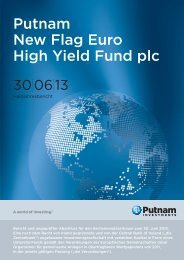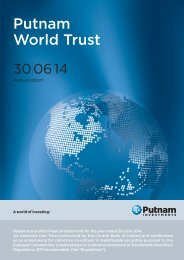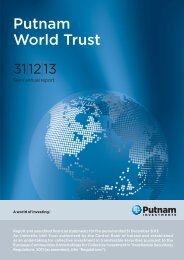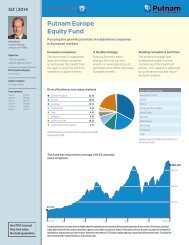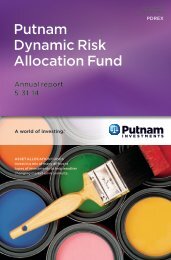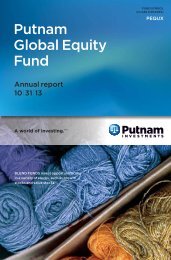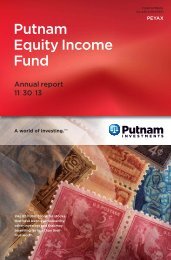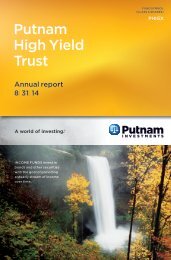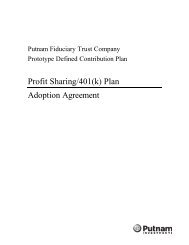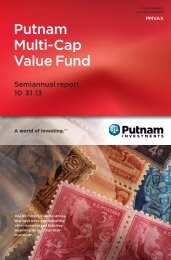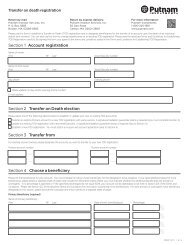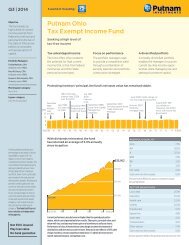quarterly commentary - Putnam Investments
quarterly commentary - Putnam Investments
quarterly commentary - Putnam Investments
You also want an ePaper? Increase the reach of your titles
YUMPU automatically turns print PDFs into web optimized ePapers that Google loves.
Q2 | 2013 » <strong>Putnam</strong> Global Income Trust Q&A<br />
Global bond markets decline<br />
as investors deliberate the<br />
impact of reduced Federal<br />
Reserve bond buying<br />
D. William Kohli<br />
Co-Head of Fixed Income, Portfolio Manager<br />
Additional Portfolio Managers<br />
Kevin F. Murphy<br />
(industry since 1988)<br />
Michael J. Atkin<br />
(Industry since 1988)<br />
Not shown<br />
Michael V. Salm<br />
(industry since 1989)<br />
Key takeaways<br />
•Global bond markets fell in May and June, as investors contemplated the end<br />
of massive liquidity from the U.S. Federal Reserve’s bond-buying program.<br />
•The fund’s overweight exposure to the strengthening U.S. dollar aided<br />
performance during the quarter, as did our holdings of commercial mortgagebacked<br />
securities.<br />
•Our mortgage credit holdings and our allocation to high-yield bonds generated<br />
positive returns early in the period before investors began to shed risk in May, but<br />
the positions remained positive overall for the quarter.<br />
•We have a generally positive outlook for global economic growth and are seeking<br />
to capitalize on opportunities in spread sectors exhibiting improved relative value.<br />
What was the global bond market environment like in the second<br />
quarter of 2013<br />
Bond markets around the world were influenced by improving U.S. economic<br />
data, which sparked debate among investors about when the Federal Reserve<br />
would begin to scale back its stimulative bond-buying program. These concerns<br />
intensified in June, when Fed Chairman Ben Bernanke announced that the central<br />
bank could begin reducing its stimulus program later in 2013, and end it by mid<br />
2014, sooner than investors expected. Spread sectors — meaning sectors that<br />
trade at a yield premium to U.S. Treasuries — which had been buoyed by the<br />
massive liquidity created by the Fed’s asset purchases, sold off, with emergingmarket<br />
[EM] bonds getting hit particularly hard. Global government bonds also<br />
fell, although not to the same degree as sectors entailing greater risk.<br />
PUTNAM INVESTMENTS | putnam.com<br />
What prompted Chairman Bernanke’s announcement<br />
U.S. economic data has been slowly improving, including signs that employment<br />
is picking up, while inflation has continued to hover below the Fed’s target of<br />
two-and-a-half-percent. I think it’s important to note, however, that the central<br />
bank hasn’t taken direct action yet. After Chairman Bernanke’s comments,<br />
several other Fed officials tried to reassure the market that the tapering of bond<br />
purchases remained data dependent and that the cutback in purchases doesn’t<br />
mean that a policy shift to raising rates would be forthcoming anytime soon. In<br />
our view, the debate about when the Fed will begin curtailing quantitative easing<br />
is healthy because it allows investors to think about what the financial markets<br />
will look like when major sectors are no longer being propped up by massive<br />
government intervention.
Q2 2013 | Global bond markets decline as investors deliberate the impact of reduced Federal Reserve bond buying<br />
How did your currency strategy affect the<br />
fund’s performance<br />
In early May, the U.S. dollar began to strengthen<br />
versus other major currencies, so our substantial dollar<br />
overweight versus the benchmark aided relative performance.<br />
Underweight exposure to the Japanese yen also<br />
provided a boost, as the yen weakened significantly<br />
following the Bank of Japan’s announcement that it<br />
would take a more aggressive approach to monetary<br />
easing. By mid quarter, we had significantly reduced the<br />
fund’s currency risk by cutting back most of our active<br />
foreign currency positions, particularly in emerging<br />
markets. We felt this was prudent in light of heightened<br />
risk in the marketplace.<br />
How did the fund’s mortgage-related<br />
strategies work out<br />
Our mortgage prepayment strategies hurt the fund’s<br />
results overall for the quarter. As the quarter began,<br />
given the uncertainty about Fed policy, the pace of<br />
home refinancing, and that interest rates are still at low<br />
levels, our holdings of collateralized mortgage obligations<br />
[CMOs] significantly underperformed. However,<br />
the sector rebounded nicely in June, and we sought to<br />
capitalize on CMOs’ improved relative value by boosting<br />
the portfolio’s allocation. With the increase in interest<br />
rates, interest-only [IO] CMOs did particularly well,<br />
because higher rates led to slower prepayments of the<br />
mortgages underlying the securities.<br />
Conversely, our mortgage credit holdings — both<br />
non-agency residential mortgage-backed securities<br />
[RMBS] and commercial mortgage-backed securities<br />
[CMBS] — helped performance, especially earlier in<br />
the quarter, as investors took advantage of attractive<br />
spreads and positive underlying fundamentals in the<br />
sector. As the quarter progressed, we sought to reduce<br />
risk by shifting the fund’s allocation from RMBS into<br />
CMBS, which were performing better.<br />
How did the fund’s allocation to corporate<br />
credit influence performance<br />
Our holdings of investment-grade and high-yield<br />
corporate bonds were slightly beneficial, as strong<br />
performance in April was only partially offset by the<br />
sell-off that occurred in May and June. Similar to EM<br />
debt and non-agency RMBS, high-yield bonds were<br />
hampered more by capital flows and market “technicals”<br />
[that is, supply and demand dynamics] than any<br />
breakdown in fundamental support. In fact, the fundamental<br />
backdrop for high-yield bonds remained solid;<br />
issuers are in reasonably good financial shape and the<br />
default rate remained low at quarter-end. Moreover,<br />
high-yield bonds have historically tended to do well<br />
during periods of moderate economic growth.<br />
What is your outlook for the months ahead<br />
We believe the U.S. economic recovery is on track and<br />
should continue at a moderate pace. Despite higher<br />
mortgage rates, we believe the U.S. housing recovery<br />
will continue. In our view, home sales are improving<br />
because of stronger economic activity and better<br />
consumer confidence, and not solely because of low<br />
mortgage rates. Outside the United States, the global<br />
environment appears to be relatively stable, except for<br />
China, where weaker growth and high consumer debt<br />
levels have created challenges for a government that is<br />
trying to stimulate domestic demand.<br />
Peripheral eurozone economies have performed<br />
better than we anticipated, thanks to sharply lower<br />
interest rates in those countries. Core European economies<br />
were somewhat weaker than we expected but,<br />
near the end of the quarter, data from Germany, the<br />
Netherlands, and Switzerland was encouraging.<br />
As for interest rates, while we believe global rates are<br />
likely to move higher over the medium to longer term,<br />
we think the degree of increase during the quarter was<br />
more than the current economic environment warrants.<br />
Consequently, in order to tactically position the fund<br />
to potentially benefit from any near-term fall in rates,<br />
we modestly lengthened the portfolio’s duration by<br />
quarter-end.<br />
Where are you finding the most attractive<br />
investment opportunities<br />
Following the liquidity-driven sell-off in various spread<br />
sectors, we selectively added back CMBS and added<br />
more modestly to high-yield bonds, seeking to benefit<br />
from the improved relative value in these sectors. We<br />
also increased our allocations in peripheral European<br />
government bonds, specifically in Italy, Spain, and<br />
Greece. In addition to the improved economic backdrop<br />
in these countries, we think these bonds offer favorable<br />
technical characteristics versus the bond markets in<br />
many developing nations.<br />
PUTNAM INVESTMENTS | putnam.com 2
Q2 2013 | Global bond markets decline as investors deliberate the impact of reduced Federal Reserve bond buying<br />
<strong>Putnam</strong> Global Income Trust (PGGIX)<br />
Annualized total return performance as of June 30, 2013<br />
Class A shares<br />
(inception 6/1/87) Before sales charge After sales charge<br />
Barclays Global Aggregate<br />
Bond Index<br />
Last quarter -2.61% -6.50% -2.80%<br />
1 year 3.30 -0.83 -2.18<br />
3 years 5.34 3.92 3.55<br />
5 years 6.74 5.87 3.68<br />
10 years 6.10 5.67 4.79<br />
Life of fund 7.11 6.94 —<br />
Total expense ratio: 1.10%<br />
Returns for periods of less than one year are not annualized.<br />
Current performance may be lower or higher than the quoted past performance, which cannot guarantee future results.<br />
Share price, principal value, and return will vary, and you may have a gain or a loss when you sell your shares. The class<br />
A share performance shown assumes reinvestment of distributions and does not account for taxes. After-sales-charge<br />
returns reflect a maximum load of 4.00%. For a portion of the periods, the fund had expense limitations, without which<br />
returns would have been lower. To obtain the most recent month-end performance, visit putnam.com.<br />
Barclays Global Aggregate Bond Index is an unmanaged index of global investment-grade fixed-income securities.<br />
You cannot invest directly in an index.<br />
The views and opinions expressed are those of the portfolio managers as of June 30, 2013, are subject to change with<br />
market conditions, and are not meant as investment advice. All performance and economic information is historical and<br />
is not indicative of future results.<br />
Consider these risks before investing: International investing involves currency, economic, and political risks. Emergingmarket<br />
securities carry illiquidity and volatility risks. Lower-rated bonds may offer higher yields in return for more risk.<br />
Funds that invest in government securities are not guaranteed. Mortgage-backed securities are subject to prepayment<br />
risk and the risk that they may increase in value less when interest rates decline and decline in value more when interest<br />
rates rise. The fund invests in fewer issuers or concentrates its investments by region or sector, and involves more risk<br />
than a more broadly invested fund. The fund’s policy of concentrating on a limited group of industries and the fund’s<br />
non-diversified status, which means the fund may invest in fewer issuers, can increase the fund’s vulnerability to common<br />
economic forces and may result in greater losses and volatility. Bond investments are subject to interest-rate risk (the<br />
risk of bond prices falling if interest rates rise) and credit risk (the risk of an issuer defaulting on interest or principal<br />
payments). Interest-rate risk is greater for longer-term bonds, and credit risk is greater for below-investment-grade<br />
bonds. Risks associated with derivatives include increased investment exposure (which may be considered leverage)<br />
and, in the case of over-the-counter instruments, the potential inability to terminate or sell derivatives positions and the<br />
potential failure of the other party to the instrument to meet its obligations. Unlike bonds, funds that invest in bonds have<br />
fees and expenses. Bond prices may fall or fail to rise over time for several reasons, including general financial market<br />
conditions and factors related to a specific issuer or industry. You can lose money by investing in the fund.<br />
Request a prospectus or summary prospectus from your financial representative or by calling 1-800-225-1581.<br />
The prospectus includes investment objectives, risks, fees, expenses, and other information that you should read<br />
and consider carefully before investing.<br />
<strong>Putnam</strong> Retail Management<br />
<strong>Putnam</strong> <strong>Investments</strong> | One Post Office Square | Boston, MA 02109 | putnam.com EO135 281761 7/13



